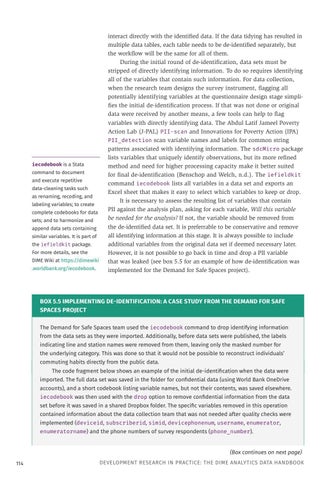iecodebook is a Stata command to document and execute repetitive data-cleaning tasks such as renaming, recoding, and labeling variables; to create complete codebooks for data sets; and to harmonize and append data sets containing similar variables. It is part of the iefieldkit package. For more details, see the DIME Wiki at https://dimewiki .worldbank.org/iecodebook.
interact directly with the identified data. If the data tidying has resulted in multiple data tables, each table needs to be de-identified separately, but the workflow will be the same for all of them. During the initial round of de-identification, data sets must be stripped of directly identifying information. To do so requires identifying all of the variables that contain such information. For data collection, when the research team designs the survey instrument, flagging all potentially identifying variables at the questionnaire design stage simplifies the initial de-identification process. If that was not done or original data were received by another means, a few tools can help to flag variables with directly identifying data. The Abdul Latif Jameel Poverty Action Lab (J-PAL) PII-scan and Innovations for Poverty Action (IPA) PII_detection scan variable names and labels for common string patterns associated with identifying information. The sdcMicro package lists variables that uniquely identify observations, but its more refined method and need for higher processing capacity make it better suited for final de-identification (Benschop and Welch, n.d.). The iefieldkit command iecodebook lists all variables in a data set and exports an Excel sheet that makes it easy to select which variables to keep or drop. It is necessary to assess the resulting list of variables that contain PII against the analysis plan, asking for each variable, Will this variable be needed for the analysis? If not, the variable should be removed from the de-identified data set. It is preferrable to be conservative and remove all identifying information at this stage. It is always possible to include additional variables from the original data set if deemed necessary later. However, it is not possible to go back in time and drop a PII variable that was leaked (see box 5.5 for an example of how de-identification was implemented for the Demand for Safe Spaces project).
BOX 5.5 IMPLEMENTING DE-IDENTIFICATION: A CASE STUDY FROM THE DEMAND FOR SAFE SPACES PROJECT The Demand for Safe Spaces team used the iecodebook command to drop identifying information from the data sets as they were imported. Additionally, before data sets were published, the labels indicating line and station names were removed from them, leaving only the masked number for the underlying category. This was done so that it would not be possible to reconstruct individuals’ commuting habits directly from the public data. The code fragment below shows an example of the initial de-identification when the data were imported. The full data set was saved in the folder for confidential data (using World Bank OneDrive accounts), and a short codebook listing variable names, but not their contents, was saved elsewhere. iecodebook was then used with the drop option to remove confidential information from the data set before it was saved in a shared Dropbox folder. The specific variables removed in this operation
contained information about the data collection team that was not needed after quality checks were implemented (deviceid, subscriberid, simid, devicephonenum, username, enumerator, enumeratorname) and the phone numbers of survey respondents (phone_number).
(Box continues on next page) 114
DEVELOPMENT RESEARCH IN PRACTICE: THE DIME ANALYTICS DATA HANDBOOK





